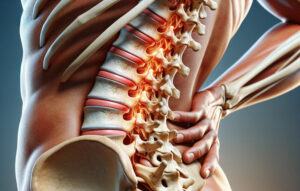Left Paracentral Disc Extrusion Explained

Left Paracentral Disc Extrusion, a complex medical condition, involves the protrusion of an intervertebral disc beyond its normal boundary in the spinal column. This condition is a specific form of disc herniation, which can occur anywhere along the spinal cord but is most commonly observed in the lumbar spine. The progression of lumbar disc extrusion can have a wide impact on both health and quality of life.
At the heart of this condition lies the spinal disc, a shock absorber between the bones of the spinal column, providing cushioning and support for the vertebrae.
Each disc consists of a tough outer wall (annulus fibrosus) and a soft, gel-like center (nucleus pulposus). In the case of a left paracentral disc extrusion, the nucleus pulposus breaches through a weakened area of the annulus fibrosus, extending toward the left paracentral region of the spinal canal.
This extrusion can compress the adjacent nerve root, leading to symptoms like back pain, neck pain, or radiating pain in the limbs. An expert neurosurgeon in Dallas with experience in spinal issues and minimally invasive spine surgery would be a great person to discuss these issues with.
The severity of symptoms depends on the degree of nerve compression and the location of the herniated disc. Lumbar disc herniation, for example, may result in sciatica, characterized by sharp pain traveling down the leg, while cervical disc herniation can cause neck pain and discomfort in the arms.
Physical therapy plays a vital role in managing the symptoms of disc extrusion. It focuses on strengthening the spinal muscles, improving posture, and alleviating nerve root compression.
In more severe cases where conservative therapy, including pain medication and physical therapy, proves insufficient, surgical options may be considered.
These might include minimally invasive spine surgery, such as endoscopic spine surgery or laser disc repair, or more traditional approaches like spinal fusion. These procedures aim to relieve pressure on the nerve root and stabilize the affected spinal region.
Understanding the risk factors contributing to disc extrusion is crucial. Poor posture, excessive strain on the spinal discs from activities like heavy lifting, or trauma from incidents such as a car accident can increase the likelihood of disc herniation.
In some cases, degenerative changes in the spine, often linked with aging, can lead to weakened disc structures, making them more susceptible to extrusion.
This introduction serves as an overview of left paracentral disc extrusion, a condition that can significantly impact the quality of life.
It's important to recognize the symptoms early and seek appropriate medical evaluation and treatment to manage the condition effectively and prevent further complications.
Understanding Left Paracentral Disc Extrusions
Left paracentral disc extrusion is a specific type of disc herniation where the disc material extrudes to the left side of the spinal canal, primarily affecting the lumbar spine.
This condition differs from general disc extrusions due to its precise location and the potential for affecting the nerve root in a distinctive manner.
Further Reading & Research
Anatomical Characteristics of these types of Herniated Discs
In left paracentral disc extrusion, the nucleus pulposus, or the soft center of the spinal disc, protrudes through a tear in the annulus fibrosus, the disc's tough outer layer.
This protrusion occurs towards the left side of the spinal canal, where it can impinge on the nerve root, leading to symptoms like pain, numbness, and weakness predominantly on one side of the body.
Discs, the Spinal Column and Disc Herniation
The spinal discs act as shock absorbers between the vertebrae in the spinal column. In the case of a left paracentral disc extrusion, these discs start to bulge asymmetrically, impacting the left side more significantly. This uneven pressure can lead to the deterioration of the disc's outer part and eventual extrusion.
Nerve Involvement and Symptoms
The herniated disc material can compress the spinal cord or the exiting nerve roots, leading to symptoms such as back pain, sciatica, and in severe cases, cauda equina syndrome. The lumbar region is most commonly affected, resulting in lower back pain and radicular symptoms.
Worried About This?
BOOK AN APPOINTMENT WITH DR BAKER
The Mechanics of a Herniated Disc
Understanding Disc Herniation in the Spinal Structure
Disc herniation is a condition that involves the displacement of disc material beyond the intervertebral disc space. This process begins in the spinal discs, which are cushion-like pads situated between the vertebrae of the spine. These discs are made up of a tough, outer layer called the annulus fibrosus and a soft, gelatinous inner portion known as the nucleus pulposus.
The Onset of Herniation
Herniation typically occurs when the nucleus pulposus protrudes through a tear or a weakened area in the annulus fibrosus. This can happen due to various factors, including age-related wear and tear, acute injury, or repetitive strain on the spine. When the disc material protrudes out, it can put pressure on the spinal cord or nerve roots, leading to symptoms like pain, numbness, or weakness.
Disc Extrusion vs. Bulging Disc
While both disc extrusion and a bulging disc are forms of disc herniation, they differ in their characteristics. A bulging disc involves the extension of the disc
beyond its normal perimeter in the spinal column, typically involving a large portion of the disc circumference. This bulge generally does not break through the outer layer of the disc but extends out evenly, like a hamburger bun that is too small for the patty.
The Specificity of Disc Extrusion
In contrast, disc extrusion is a more pronounced form of herniation. Here, the nucleus pulposus breaks through the annulus fibrosus but remains confined within the disc material or under the posterior longitudinal ligament of the spinal canal. The extrusion can be focal, affecting a specific area, or broad, impacting a larger part of the spinal column.
The Consequences of Herniated Discs
The impact of a herniated disc, whether it is an extrusion or a bulging disc, primarily depends on the location and size of the herniation. If the herniated material compresses the spinal nerve roots, it can lead to significant pain, reduced mobility, and even neurological deficits.
Spinal Discs: The Backbone of Movement
Spinal discs play a crucial role in the flexibility and mobility of the spine. Their ability to absorb shocks and facilitate movement makes them vital, yet vulnerable to damage and degeneration, leading to conditions like disc herniation.
Causes and Risk Factors of Left Paracentral Disc Extrusion
Identifying the Root Causes
Left paracentral disc extrusion, a specific type of herniated disc, occurs when the disc material protrudes into the left paracentral area of the spinal canal. This condition often stems from several key factors, some of which are modifiable, while others are inherent to the individual's health or genetics.
Age-Related Degeneration: A Primary Factor
As individuals age, spinal discs naturally lose hydration and elasticity, making them more susceptible to herniation. The degeneration of the disc material, combined with the stress of daily activities, can lead to tears in the outer layer of the disc, allowing the inner gel-like material to protrude.
Lifestyle and Postural Influences
Lifestyle choices, such as engaging in heavy lifting, high-impact sports, or prolonged sitting, can increase the risk of disc extrusion. Poor posture, especially when working at a desk or using mobile devices, contributes significantly to spinal stress and disc damage.
The Role of Physical Activity
A lack of regular physical activity can weaken the spinal muscles, reducing the support for the spinal column and increasing the risk of herniated discs. Regular exercise and physical therapy are essential in maintaining spinal health and preventing conditions like disc extrusion and herniation.
Understanding Herniated Discs and Disc Extrusion
While herniated discs can occur in any part of the spine, left paracentral disc extrusion is particularly notable for its position, impacting the nerve roots and potentially leading to pain and neurological symptoms. Disc extrusion differs from bulging discs in that the disc material extends beyond the normal boundaries of the intervertebral space, directly impacting spinal nerves.
The Consequences of Untreated Disc Herniation
If left untreated, a herniated disc can lead to chronic pain, decreased mobility, and in severe cases, conditions like cauda equina syndrome. Early diagnosis and treatment are crucial in managing the condition and preventing further spinal damage.
Conclusion
Comprehensive Understanding and Treatment Approaches
Left paracentral disc extrusion, a specific form of herniated disc, poses unique challenges due to its position in the spinal column. This condition, if not addressed properly, can significantly affect the spine's integrity and an individual's overall well-being.
The Role of Pain Management
Managing pain associated with left paracentral disc extrusion is paramount. Pain medication, often in conjunction with physical therapy, plays a critical role in alleviating discomfort and improving quality of life. However, it's important to approach pain management holistically, considering long-term effects and dependency issues.
Surgical Options: A Last Resort
In cases where conservative therapy fails, and the disc extrusion severely compromises nerve function or leads to conditions like cauda equina syndrome, surgery may be required. Options vary depending on the severity and location of the extrusion, ranging from minimally invasive procedures like spinal decompression to more extensive surgeries such as spinal fusion.
Importance of Early Diagnosis
Early diagnosis is critical in managing left paracentral disc extrusion effectively. Medical imaging techniques like CT scans can aid in identifying the extent of the herniation and guide treatment options. Experiencing pain, especially when accompanied by symptoms like foot drop or changes in nerve signals, should prompt immediate medical consultation.
Emphasis on Lifestyle Modifications
Modifiable risk factors like poor posture, obesity, or strenuous physical activities contribute significantly to the development of disc extrusions. Addressing these through lifestyle changes, including adopting ergonomic practices and engaging in exercises that strengthen the lower neck and spine, can help in managing and preventing future occurrences.
The Role of Physical Therapy
Physical therapy, often involving exercises that target the spinal discs and surrounding muscles, is crucial in both treatment and prevention. A physical therapist can guide patients through targeted exercises and stretches, which help in maintaining spinal alignment and relieving pressure on the affected area.
Dr. Abdul Baker - An Expert Neurosurgeon in Texas
Every neurosurgery has its complications; thus, a patient must choose the best neurosurgeon for himself. Dr. Abdul Baker is one of the most experienced and qualified neurosurgeons in Texas, treating patients for more than 16 years. People in Sherman, Plano, and nearby areas trust him for every kind of neurosurgery due to his surgical procedures’ 100% success rate. You may visit him if you need any consultancy or treatment regarding your brain and spine disorders.


Dr. Baker specializes in neurosurgery, neurosurgical spine surgery, neurotrauma, brain tumors, spinal tumors, and peripheral nerve damage treatment.









